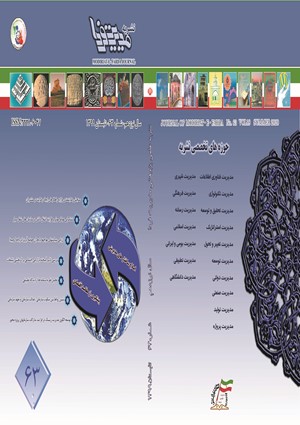Relational capital: The key of success to reach comparative merit
Subject Areas :parastoo soltanii 1 , sakineh Shahi 2 , yadollah mehralizadeh 3
1 -
2 -
3 -
Keywords: intellectual capital human capital Relational Capital structural capital.,
Abstract :
The purpose of this study was to investigate the status of intellectual capital and its improvement strategies in one of the organizations affiliated to the Ministry of Energy. The research method was mixed- exploratory blend. The survey method in the quantitative part and content analysis in the qualitative section was used. Participants in quantitative part were all staff members of the organization, that 268 were selected randomly. In qualitative section, a purposeful sampling method was used and semi-structured interview was conducted with 12 managers by over 15 experiences. The instruments of this research were questionnaire, interview and analysis of documents. In quantitative part, the Bontistis standard questionnaire used. The reliability of this questionnaire obtained 0/79 by Cronbach Alpha. The interviews were analyzed by open and axial coding. Quantitative findings showed that the mean scores of respondents in relation to the existing status of human, structural and structural indicators were higher than expected average. Also, the qualitative findings indicate that the capital and human capital indicators in the organization have a relatively good status in the organization. Finally, suggested solutions such as: identifying staff talents and making the best, have a plan for train substitution, and create a comprehensive communication system.
1- اسکندری، ف. (1394). بهینه¬گزینی و افشای شاخص¬های سرمایه فکری مرتبط با آموزش در شرکت بهره ¬برداری نفت و گاز مارون اهواز. پایان¬نامه کارشناسی ارشد مدیریت آموزشی، دانشگاه شهید چمران اهواز.
2- آقاجان¬زاده، ح. (1390). بررسی رابطه بین مدیریت دانش و سرمایه¬ی فکری در شرکت سهامی بیمه آسیا شهر تهران. پایان نامه کارشناسی ارشد دانشگاه تهران.
3- حسینی، ش. (1389). تدوین الگوی بومی شاخصهای سرمایه فکری و اندازه گیری آنها در دانشگاه شهید چمران اهواز طی برنامه چهارم توسعه (1387-1384)، پایان نامه کارشناسی ارشد مدیریت آموزشی.
4- سعادت، س. (1393). بررسی سیاستها و استراتزی های سازماندهی آموزش مداوم در شرکت فولاد مبارکه استان اصفهان. پایان نامه کارشناسی ارشد مدیریت آموزشی، دانشگاه شهید چمران اهواز.
5- ستایش، م ح؛ کاظم نژاد، م. (1388). روش¬های اندازه¬گیری و گزارشگری خارجی سرمایه فکری. ماهنامهی حسابدار تهران. 24 (207)، صص. 63-58.
6- شرفی، م؛ عباس¬پور، ع. (1392). ارتباط بین سرمایه فکری و عملکرد در دانشگاه¬ها و موسسات آموزش عالی. دو ماهنامه راهبردهای آموزش در علوم پژشکی. 6 (2)، صص.81-76.
7- شفیعا، م ع؛ سهرابی، ب؛ رییسی، انانی و فقیه میرزایی، س. (1388). مدلی برای سنجش تحلیلی مولفه های سرمایه های فکری. زنجان: اولین کنفرانس بین¬اللملی مدیریت سرمایه¬های فکری.
8- عالم تبریز، ا؛ حاجی بابا، ع، و رجبی¬فرد، ا (1388). سرمایه فکری، اندازه¬گیری، افشاء، مدیریت. تهران: مرکز آموزش و تحقیقات صنعتی ایران.
9- علوی، س ع؛ قرشی س ر. (1386). الگوی اندازه¬گیری سرمایه فکری در سازمان های ایرانی، فصلنامه اندیشه مدیریت، 1 (2).
10- قلیچ لی، ب؛ مشبکی، ا. (1389). نقش سرمایه اجتماعی در ایجاد سرمایه فکري سازمان (مطالعه دو مورد شرکت خودروساز ایرانی). فصلنامه دانش مدیریت. 75(19)، صص.147-125.
11- مجتهد زاده، و؛ علوی طبری، س ح و مهدی¬زاده، م. (1389). رابطه سرمایه فکری (انسانی، رابطه¬ای، ساختاری) و عملکرد صنعت بیمه از دیدگاه مدیران. مجله¬ بررسیهای حسابداری و حسابرسی. دانشکده مدیریت دانشگاه تهران. 17 و60. 119-109.
12- نعمتی، م ع. (1384). مدیریت دانش و آموزش عالی: مفاهیم و رهیافت¬ها. ماهنامه¬ی آموزش عالی تهران، فروردین. 12، صص.19-14.
13- Bontis, N. Chun Wei Choo(2003). The strategic management of intellectual capital and organization knowledge, Oxford university press.
14-Cerchione, R. Esposito, E. (2017). Using knowledge management systems: A taxonomy of SME strategies. International Journal of Information Management, Volume 37, Issue 1, Part B, February 2017, Pages 1551-1562.
15-Chen (2004)”Measuring intellectual capital: a new model and empirical incompany annual reports Evidence from Malaysia” Journal of Intellectual Capital. Vo1. 5 No. 3, pp. 500-510.
16-Corcoles, Y. R. Santos Penalver, J. And Ponce, A. T. (2011). Intellectual capital in Spanish Public universities: stakeholders, information needs. Journal of Intellectual Capital. Vo1.1No.3, pp, 365-376.
17-Delgado-Verde, M.., Martín-de Castro, G. & Amores-Salvadó, J. (2016). “Intellectual capital and radical innovation: Exploring the quadratic effects in technology-based manufacturing firms”, Technovation, 54: 35- 47.
18- Diver, Sibyl . (2017). Negotiating Indigenous knowledge at the science policy-interface: Insights from the Xáxli’p Community Forest. Environmental Science & Policy, Volume 73, July 2017, Pages 1-11.
19-Gottschalk, P. (2005). Strategic knowledge management technology. Idea grope Publishing.
20- Martines, Isabele, (2009). « The importance of Intellectual Capital in Organization», Dissertation Abstract PH. D] university of Glomorgan Business School, Ponty pridd UK.
21-Marr, B (2005) “ Defining intellectual capital: a three-dimensional approach” Mnagement Decision vo1. 43No. 9, pp.
22-Olszewska, A. N. (2017). Research Issues Undertaken within Quality Management – Overview of Selected Literature and a Knowledge Map. Procedia Engineering, Volume 182, 2017, Pages 518-523.
23-Szafrański, M. (2017). Problem of Language Used to Describe Competences in the Management of Acceleration in the Creation of Knowledge Resources in Businesses. Procedia Engineering, Volume 182, 2017, Pages 679-686.
24-Unger, J. M; Rauch, A; Frese, M; Rosenbusch, N. (2011). "Human capital and entrepreneurial success: A meta-analytical review", Journal of Business Venturing, Vol. 26, pp: 341–358.


